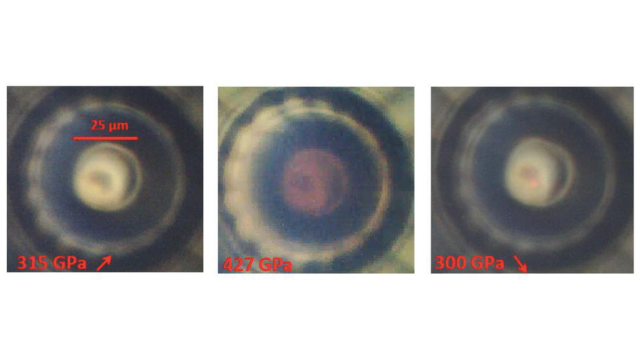Physicist Eugene Paul Wigner predicted more than 80 years ago that hydrogen, the most abundant element in the universe, could turn into an electricity-conducting solid metal at the right temperature and pressure. Scientists have spent decades since attempting to synthesise this material, and may have finally done so.
A team of researchers in France has posted a paper on the arXiv physics preprint server describing their observation of metallic hydrogen under pressures greater than those inside Earth’s core. Several times, other researchers have claimed to discover this phase of matter, claims that are generally met with varying levels of scepticism. But some experts think that this newest claim could be the real deal.
Metallic hydrogen is exactly what it sounds like—a state of the element hydrogen where it has the properties of a metal. The substance should “indisputably” exist, according to the new paper, thanks to something called quantum confinement: restrict electrons’ motion enough, and the electronic and optical properties of the material change thanks to the rules of quantum mechanics.
At high enough pressures, any insulator should become a conductive metal, according to the paper; oxygen becomes a metal at 100 GPa, around a million times the pressure of Earth’s air at sea level, for example.
The discovery of metallic hydrogen would be exciting for a few reasons. Of course, it would prove experimentally that the material existed. It might transmit electricity without heating up, meaning it would be a superconductor, perhaps even a room-temperature superconductor.
That’s another long-sought goal of physicists and could revolutionise electronics. Further, such a metal might fill the centres of massive planets like Jupiter, so being able to create it here on Earth could help us learn more about those planets.
The researchers, led by Paul Loubeyre at France’s Atomic Energy Commission, first produced solid molecular hydrogen by compressing hydrogen gas between diamond tips to 310 GPa, as has been shown previously by this group and others.
Then, they further cranked up the pressure and analysed how the sample absorbed infrared radiation produced by a particle accelerator in France called the SOLEIL synchrotron. At around 425 GPa and 80 degrees above absolute zero (0 Kelvin, the temperature where all matter has the minimum amount of heat), the sample suddenly started absorbing all of the infrared radiation.
This signalled to the researchers that they’d “closed the band gap,” meaning the solid material no longer required an input of energy for its electrons to jump into a state such that they would conduct through the sample.
Basically, the researchers claim that they’ve squeezed the hydrogen gas enough that quantum effects now allow the electrons to flow through the sample as they would in a metal.
Two advances allowed the researchers to achieve their observation, according to the paper. First, rather than being flat, the diamonds tips were toroidal, meaning they had an outer flat surface, a doughnut-shaped space, and an inner flat surface.
This allowed the scientists to overcome a previous 400 GPa limit faced by their other diamond anvil cells. Second, the researchers designed a new kind of infrared microscope that would allow them to measure the sample.
It’s important to note that this result has not been peer reviewed, meaning it does not yet appear in a major scientific journal and hasn’t been reviewed by other experts in the field. Nor have other researchers independently verified the discovery just yet.
Scientists, including Loubeyre, treated the 2017 metallic hydrogen claim with a heavy dose of scepticism, and another team regretted making such a strong claim in their own 2012 discovery, Nature reported.
But something feels different about this new paper. “I think this is really a Nobel-prize worthy discovery,” high-pressure physicist Maddury Somayazulu at Argonne National Laboratory, not involved in this study, told Gizmodo in an email.
“It always was, but this probably represents one of the cleanest and most comprehensive pieces of work on pure hydrogen.” He explained that he knew Paul Dumas, the study’s lead author from SOLEIL “very well,” and that Dumas was an “incredibly careful and systematic scientist.”
Another physicist who was not convinced by the 2017 announcement, Alexander Goncharov from Geophysical Laboratory, also felt more confident about the new result. “I think that the paper contains some good evidences about the the band gap closure in hydrogen,” he told Gizmodo. “Some of the interpretation is incorrect and some data could be better, but I generally trust that this is valid.”
Helen Maynard-Casely, instrument scientist at the Australian Nuclear Science and Technology Organisation who has previously written on the search for metallic hydrogen, mentioned in a tweet that this paper has generated a lot of buzz in the community.
Have scientists finally discovered metallic hydrogen? Is it time for researchers to book their tickets to the Nobel Prize ceremony in Stockholm? No, unfortunately not. Maynard-Casely cautioned in another tweet that we’ll need to wait to see if the paper passes through the months-long peer review process.
But it’s certainly an exciting time in the field, and scientists might finally be able to produce metallic hydrogen inside of diamond tips. Unscrewing the diamonds without losing the metal, well, that’s another story.
